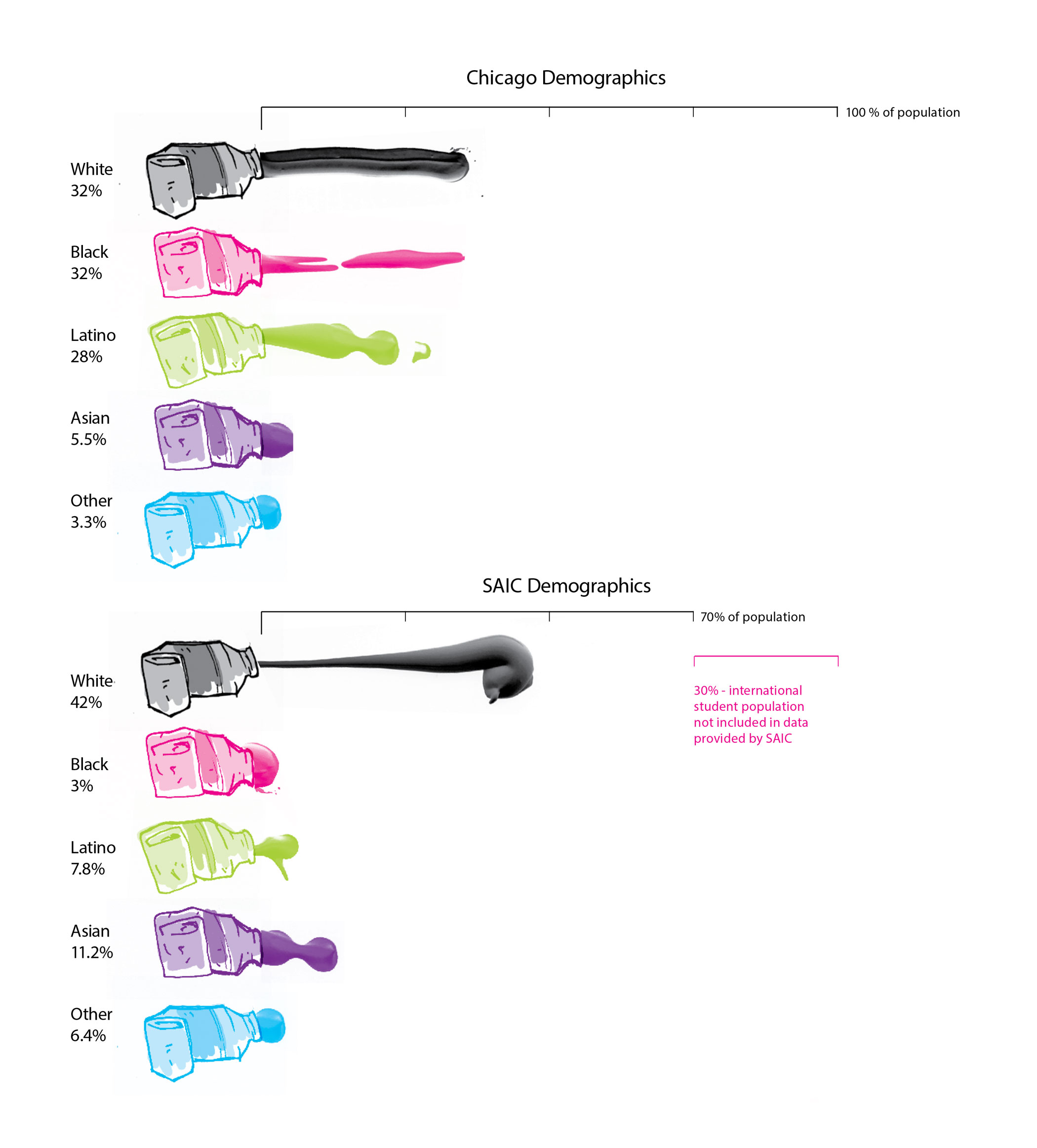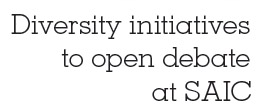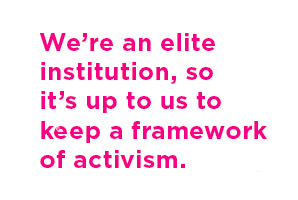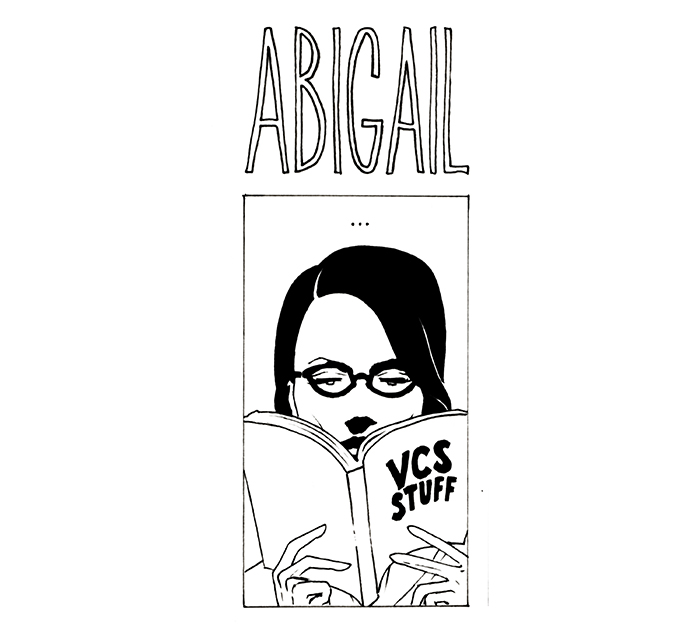Illustrations by Jordan Whitney Martin
When it comes to measuring the lack of diversity at the School of the Art Institute of Chicago (SAIC), it’s an easy game of disproportionate numbers. For example, even though Chicago has a Latino population of about 29%, SAIC only reaches 7.8% in its student body. And, when it comes to black communities, SAIC’s 3% looks miniscule next to Chicago’s 32%. Finding a problem with race at SAIC appears to be pretty cut and dry.
But, when it comes to defining diversity, things get muddled.
“[Diversity] is very contextual, which means that we’re constantly having to evolve,” said Kelly Humrichouser, the Special Assistant to the Dean of Diversity and Inclusion. “‘Diversity’ and ‘inclusivity’ get tossed around a lot, but we’ve got to keep asking ourselves ‘Inclusive of what’?”
This answer grows more complicated as the hegemonic, whitewashed culture in which SAIC participates, awakens to integrational failures, the dangers of LGBTQ assimilation, and the pervasiveness of gendered violence. In response to these oppressions, SAIC will try to put forth a series of choreographed paradoxes with radical Leftism and elite academic tradition as it rolls out its diversity initiatives into the 2015-’16 school year.
“One of the ultimate goals of these initiatives is to make students’ experiences at SAIC larger than the oppressions they face,” Humrichouser said. “We’re constantly asking ourselves how we continue building a community that values these voices and becomes more inclusive without just checking off different identity boxes. That’s why we brought in the concept of intersectionality.”
To understand the initiatives put in place by SAIC’s Diversity Advisory Group (DAG), it’s important to have a grip on “intersectionality,” a term formally coined and introduced to feminist theory by Kimberlé Crenshaw. Intersectionality is a theoretical framework that unpacks systems of oppression by taking into account the interactions between points of identity.
“Black feminism is the example we use to explain this theory,” noted Humrichouser. In order to magnify the simultaneous oppressions faced by black, feminine identities, black feminism puts on trial the connections between race, gender, and sexuality.
“We want to create a culture on campus where these difficult conversations are possible,” Humrichouser continued. “And, we’re proud that this kind of change is happening at SAIC.”
 Rashayla Marie Brown, Director of Student Affairs for Diversity and Inclusion, shares this excitement and stated that the changes in diversity programing make SAIC unique.
Rashayla Marie Brown, Director of Student Affairs for Diversity and Inclusion, shares this excitement and stated that the changes in diversity programing make SAIC unique.
To solidify the structure of the DAG, Brown and her team made collaborative changes. One of these adjustments is that Brown’s position no longer tackles sexual harassment cases, and, instead, provides support to student groups like the League of Extraordinary Genders, and is a first point of contact for students looking to expand their cultural understandings.
“The newer structure is the result of recommendations made by several committees and symposia,” Brown said. She pointed out that most academic institutions hire one provost of diversity and expect this role to cater to student and faculty communities alike. “Ultimately, we found that this kind of setup provided no power to create change and spread leaders too thinly.”
“We decided to create positions along our different bureaucratic levels to value and address distinct needs,” Brown illustrated. This included the creation of Humrichouser’s position, which reports to Lisa Wainwright, the Vice President of Academic Affairs.
SAIC also brought on Christina Gomez as Director of Academic Affairs for Diversity and Inclusion. Humrichouser said that Gomez’s role will facilitate communication between administration and academics. One example of this work includes Gomez’s investigation of diversity within individual department curricula, where she will gauge who’s being represented through the assigned literature and stretch these boundaries where needed. Humrichouser hopes this could result in curricula that demand student engagement with multiple identities.
SAIC’s current diversity initiatives came into fruition back in 2009, as the DAG formed and designed plans to “build diversity” among faculty, students, and the curricula. It outlined specific steps and plans to increase inclusivity, borrowing “best practices” from other creative institutions and applying them to specific needs of a Chicago-based setting.
“We really want to move past the feeling of surface-level diversity, and that means producing situations that encourage a wide range of voices,” Humrichouser stated. The campus felt the first quakes of these shifts with the implementation of gender-neutral housing and bathrooms, an increase in identity-based student groups, and a reform of the student health insurance policy to specifically address the needs of the transgender community.
SAIC also saw the inauguration of a bridge program with the Chicago Public Schools that provides free college course and credits to older high school students. By beginning to preference public over charter school students, this initiative invests SAIC’s resources in a racialized school system where 39% of students are black while 9.4% are white, and where a whopping 86% are classified as “Economically Disadvantaged.”
These concepts, however, do face critique. While a diverse community does result in richer conversations and challenging work, some students and faculty fear that the semantics of “diversity” could perpetuate a culture that remains focused on hegemonic identities. Much like the use of variable and control groups in research, diversity exists because white, straight, middle-class identities remain at the center of the institution’s lens.
Brown responds to these critiques by encouraging community members to get involved.
“People need to create the environment they want to see,” she discussed. “For example, I’m a black woman in a space where that’s pretty uncommon, and I have to negotiate my feelings with that role. I love education and its imagined possibilities, so that’s why I stay with this institution.
“Sometimes the words of revolution become soft,” Brown continued, describing how the language of social justice frequently becomes nothing more than catchphrases. “This is why we have to implement these changes instead of just talking. instead of burning the institution down, people need to become involved and engaged in creating the world they wish to see. To not complain and be part of the problem, but part of creating the solutions. We’re an elite institution, so it’s up to us to keep a framework of activism.”
Correction: September 1, 2015
Because of an editing error, the graphic published in print did not include the ethnicities of Asian, American Indian, Multi-ethnic, or international students. This has been corrected in the online article to reflect a more accurate representation of the student body at SAIC.












Despite comparing Chicago demographics is still irrelevent to prove the point, the stats looks much better than the printed edition.
Hi Yubo,
The remaining 29.6% of the student population is illustrated by the graph, which accounts for approximately 30% of the student population being international. The data provided by SAIC does not list specific nationalities for international students, so the best way to represent this was to have the values of domestic students add up to about 70%.
As for the Chicago graphic, it is relevant because the school is situated in a city that is as diverse as it is segregated. Though SAIC has teamed up with Chicago Public Schools (CPS) in some really excellent ways, there is a lack of diversity that certainly remains at SAIC. To show the population of an elite institution not reflecting the city where it has been for 150 years is a sore, but relevant point.
We appreciate your feedback, Yubo!
Megan
But where’s the remaining 29.6% go (in school demographics)?